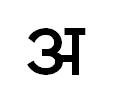Devanagari kha
- For a more general overview encompassing other Indic scripts, see Kha (Indic)
| Devanāgarī |
|---|
 |
|
Diacritics, punctuation, symbols |
Kha (ख) (खवर्ण khavarn) is the second consonant of the Devanagari abugida. It ultimately arose from the Brahmi letter 𑀔 (![]() ), after having gone through the Gupta letter
), after having gone through the Gupta letter ![]() . Letters that derive from it are the Gujarati letter ખ, and the Modi letter �.
. Letters that derive from it are the Gujarati letter ખ, and the Modi letter �.
Devanagari-using languages
In all languages, ख is pronounced as [kʰə] or [kʰ] when appropriate.
- खण्ड = khand [kʰəɳɖ] "clause, fragment"
In this example, ख implements its inherent vowel, the schwa.
- अखरोट = akhrot [əkʰroːʈ] "nonsense"
In this example, ख deletes the inherent schwa for correct pronunciation.
Certain words that have been borrowed from Persian and Arabic implement the nukta to more properly approximate the original word. It is then transliterated as a x.
- ख़राब = xaraab [xaraːb] "bad"
Mathematics
Āryabhaṭa numeration
Aryabhata used Devanagari letters for numbers, very similar to that of the Greeks, even after the invention of Indian numerals. The values of the different forms of ख are:[1]
- ख [kʰə] = 2 (२)
- खि [kʰɪ] = 200 (२००)
- खु [kʰʊ] = 20,000 (२० ०००)
- खृ [kʰri] = 2,000,000 (२० ०० ०००)
- खॢ [kʰlə] = 20×108 (२०८)
- खे [kʰe] = 20×1010 (२०१०)
- खै [kʰɛː] = 20×1012 (२०१२)
- खो [kʰoː] = 20×1014 (२०१४)
- खौ [kʰɔː] = 20×1016 (२०१६)
References
- Kurt Elfering: Die Mathematik des Aryabhata I. Text, Übersetzung aus dem Sanskrit und Kommentar. Wilhelm Fink Verlag, München, 1975, ISBN 3-7705-1326-6
- Georges Ifrah: The Universal History of Numbers. From Prehistory to the Invention of the Computer. John Wiley & Sons, New York, 2000, ISBN 0-471-39340-1.
- B. L. van der Waerden: Erwachende Wissenschaft. Ägyptische, babylonische und griechische Mathematik. Birkhäuser-Verlag, Basel Stuttgart, 1966, ISBN 3-7643-0399-9
- Fleet, J. F. (January 1911). "Aryabhata's System of Expressing Numbers". Journal of the Royal Asiatic Society of Great Britain and Ireland: 109–126. ISSN 0035-869X. JSTOR 25189823.
- Fleet, J. F. (1911). "Aryabhata's System of Expressing Numbers". The Journal of the Royal Asiatic Society of Great Britain and Ireland. Royal Asiatic Society of Great Britain and Ireland. 43: 109–126. doi:10.1017/S0035869X00040995. JSTOR 25189823.